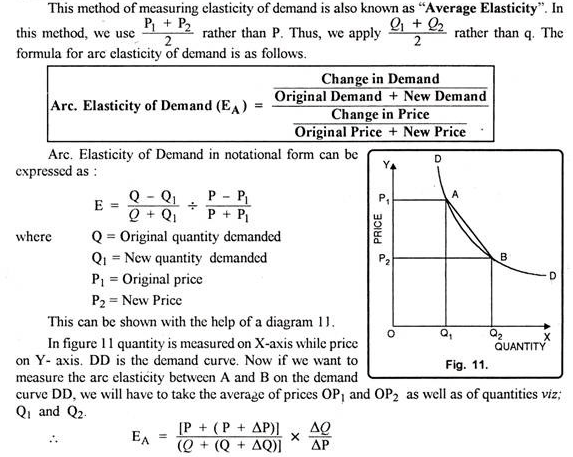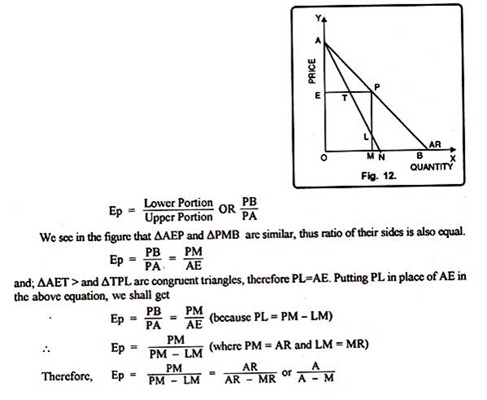PRICE ELASTICITY OF DEMAND
Price Elasticity of demand is the rate at which quantity purchased changes with the change in price. It is the ratio of percentage change in quantity demanded to percentage change in the price of the commodity, other factors remaining the same. There are three methods for measurement of Price Elasticity of Demand which are recommended by Professor Marshall.
MEASUREMENT OF PRICE ELASTICITY OF DEMAND
TOTAL EXPENDITURE METHOD OF MEASUREMENT OF PRICE ELASTICITY OF DEMAND
This method is given by Prof. Marshall. This method states that elasticity of demand can be measured from the changes in the expenditure of consumers on the commodity as its price changes. This method is also known as Total Outlay method.
Total Expenditure= Price * Quantity demanded
THREE SITUATIONS
If with the fall in the price, demand rises, the total expenditure also rises. It is the case of luxury goods. In this case, the demand will be more elastic i.e. Ed>1.
If with the fall in the price, demand rises, the total expenditure becomes constant. It is the case of goods which are comfort of life. In this case, the demand will be unitary elastic i.e. Ed=1.
If with the fall in the price, demand rises, the total expenditure also falls. It is the case of goods which are necessities of life. In this case, the demand will be less elastic i.e. Ed<1.
This method to measure the price elasticity of demand can be explained with the help of the table:
| PRICE | QUANTITY DEMANDED | TOTAL EXPENDITURE | ELASTICITY OF DEMAND | DIRECTION OF PRICE | DIRECTION OF TOTAL EXPENDITURE |
| 10 9 8 7 | 1 2 3 4 | 10 18 24 28 | GREATER THAN UNITY | DECREASES | INCREASES |
| 6 5 | 5 6 | 30 30 | EQUAL TO UNITY | DECREASES | CONSTANT |
| 4 3 2 1 | 7 8 9 10 | 28 24 18 10 | LESS THAN UNITY | DECREASES | DECREASES |
This can also be explained with the help of the curve:

In the figure from the point P3 to P2, the price falls but total expenditure increases and result in the elasticity of demand being more than one. When the price falls from P2 to P1, the total expenditure becomes constant and the elasticity of demand becomes unitary. From point P1 to O, the price falls and total expenditure also falls which makes the elasticity of demand less than one.
PROPORTIONATE METHOD OF MEASUREMENT OF PRICE ELASTICITY OF DEMAND
This method is also given by Prof. Marshall. According to this method, price elasticity of demand is the ratio of percentage or proportionate change in demand to percentage change in price. In order to measure price elasticity of demand, the proportionate change in quantity demanded is divided with the proportionate change in the price. This method is also known as Percentage Method.
Price Elasticity of demand = (-) Proportionate change in demand of the commodity/ Proportionate change in the price.
(-) (change in demand/ original demand) / (change in price / original price)
(-) (∆Q/ Q) / (∆P/P)
(-) (∆Q/Q * P/ ∆P)
GEOMETRIC METHOD OF MEASUREMENT OF PRICE ELASTICITY OF DEMAND
This method is also given by Prof. Marshall. This method is used to measure price elasticity of demand at any point on straight line demand curve. According to this method, to measure the price elasticity of demand on any given point of a straight line demand curve, the lower part of the demand curve from that point is divided by the upper part of the demand curve. That is why thus method is also known as Point Method.
Price Elasticity of Demand = Lower part of demand curve/ Upper part of demand curve.
It can be shown as:

The demand curve shows the various degrees of price elasticity of demand using the geometric method.
ARC METHOD OF MEASUREMENT OF PRICE ELASTICITY OF DEMAND
Any two points on a demand curve make an arc, and the coefficient of price elasticity of demand of an arc is known as arc elasticity of demand. This method is used to find out price elasticity of demand over a certain range of price and quantity. Thus, this method is applied while calculating PED when price or quantity demanded of the commodity is highly changed.
ACCORDING TO PROF. BAUMOL
“Arc elasticity is a measure of the average responsiveness to price change exhibited by a demand curve over some finite stretch of the curve.”
ACCORDING TO WATSON
“Arc elasticity is the elasticity at the mid-point of an arc of a demanded curve.”
ACCORDING TO LEFTWICH
“When elasticity is computed between two separate points on a demand curve, the concept is called Arc elasticity.”

REVENUE METHOD OF MEASUREMENT OF PRICE ELASTICITY OF DEMAND
Mrs. Joan Robinson has given this method. She says that elasticity of demand can be measured with the help of average revenue and marginal revenue. Therefore, sale proceeds that a firm obtains by selling its products are called its revenue. However, when total revenue is divided by the number of units sold, we get average revenue.
On the contrary, when addition is made to the total revenue by the sale of one more unit of the commodity is called marginal revenue. Therefore, the formula to measure elasticity of demand can be written as,
EA = A/ A-M
Where Ed represents elasticity of demand, A = average revenue and M = marginal revenue. This method can be explained with the help of a diagram.
In this diagram, revenue has been shown on OY- axis while quantity of goods on OX-axis. AB is the average revenue or demand curve and AN is the marginal revenue curve. At point P on demand curve, elasticity of demand is calculated with the formula,

In this way, value of Ep is one which means that price elasticity of demand is unitary. Similarly, if it is more than one, price elasticity of demand is greater than one and if it is less than one, price elasticity of demand is less than unity.
